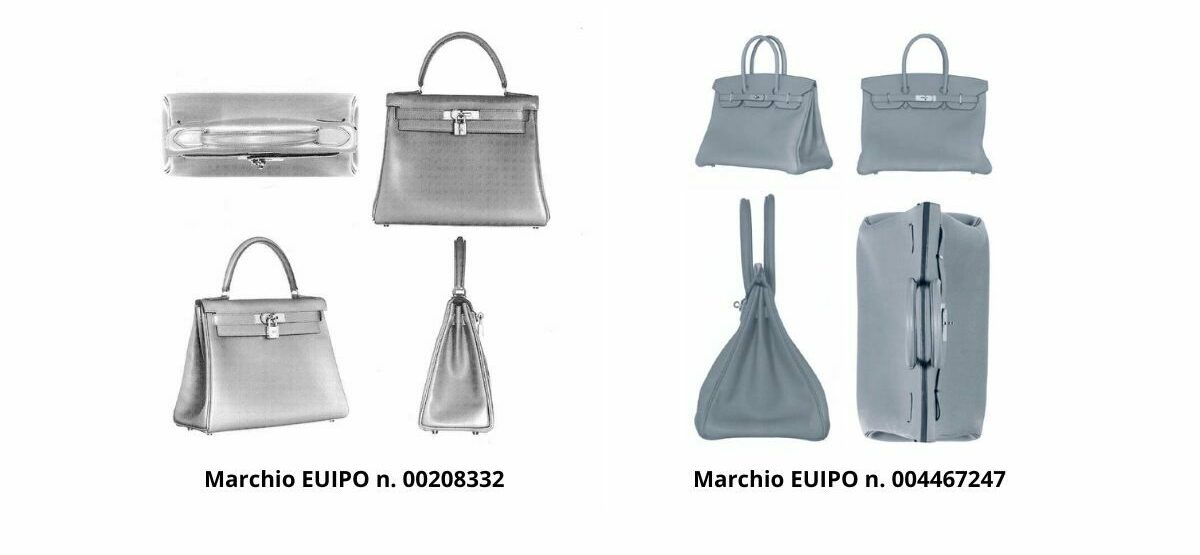We have created an interactive tool that allows you to get a customized quote
CALCULATE THE QUOTE
The article, commenting on the judgement Cass. Civ. Sec. I, No. 30455/2022, illustrates the meaning of the so-called “secondary meaning”.
The case pits the well-known fashion house Hermès and a Tuscany-based leather goods manufacturer in opposition.
Having registered and protected the “Kelly” and “Birkin” models in the EU as three-dimensional trademarks, Hermès complains of their unauthorized reproduction i.e., infringement.

The Tuscany-based manufacturer defended itself by arguing that the registrations should be considered invalid because they were insufficiently original (distinctive). Both the Tribunal and the Court of Appeals agreed with the Tuscan manufacturer, prompting Hermès to appeal to the Supreme Court.
Before focusing on the Supreme Court’s reasoning (Order of October 17, 2022 No. 30455), let’s see exactly what the law says about the so-called shape trademarks and, in particular, the phenomenon of acquired distinctiveness (“secondary meaning”).
A trend has become widespread among traders to register design patterns, decorative motifs etc. as if they were trademarks.
The reason for this is straightforward. If patents, designs etc. have a limited duration in time, trademarks can be renewed indefinitely (without time limit).
Article 7 IPC stipulates indeed that all signs, including designs and the shape of the product or the packaging of it, can be the subject of registration as long as they are suitable to distinguish the goods or services of one business from those of other businesses.
However, it is the Industrial Property Code itself that imposes certain limits on registration… let’s see what they are.
Article 9 IPC establishes that signs consisting solely of the shape imposed by the very nature of the product and the form that gives substantial value to the product cannot be registered.
As a general principle, the three-dimensional shape of a product could not be registered as a trademark when it is peculiar to the object itself, that is, inherent in its nature or function.
The case of a particularly imaginative shape, uncommon for that commodity, suitable in itself to identify and distinguish the product and/or its manufacturer, would be different.
Article 13 of the Italian Industrial Property Code indeed stipulates that signs without distinctive character, meaning those that are merely descriptive of goods or services, such as their generic names, as well as those signs that have become widespread in commercial use, cannot be registered as trademarks.
Nevertheless, the second paragraph of the above-mentioned article provides an exception to the principle: “Notwithstanding paragraph 1, signs which prior to the application for registration, as a result of the use made of them, have acquired distinctive character may be the subject of registration as a trademark”. And again, in Paragraph 3, “The trademark may not be declared or deemed invalid if prior to the filing of the application or objection of invalidity, the trademark sign, as a result of the use made of it, has acquired distinctive character”.
This could even mean that an initially trivial shape becomes recognizable due to the intensity of commercial use/exploitation.
The Supreme Court decision illustrates the meaning of the cited articles and ends up overturning the decision unfavorable to Hermes. Let’s see why.
The Supreme Court’s decision on trademark distinctiveness contrasts with what the lower courts have held.
The Supreme Court argues, in light of Article 9 CPI, that the judgment under appeal, where it states that the Kelly and Birkin bags as a whole meet the canonical parameters of bags ordinarily found in the market and that their shapes are standardized, does not explain the reasons for the lack of distinctiveness of the trademarks both originally and in light of the use and reputation acquired. As a matter of fact, the courts should have conducted a separate examination aimed at ascertaining the existence of specific cases of non-registrability.
It should also be remembered that distinctiveness can also be acquired through advertising investments that enable the public to immediately recognize the product and trace it back to a particular entrepreneur.
But how to prove the acquisition of distinctiveness?
The Supreme Court of Cassation, endorsing the jurisprudential approach of the Court of Justice of the European Union, reports that “for the purpose of assessing the acquisition of distinctiveness through use, factors such as, but not limited to:
Specifically, tools for assessing distinctiveness may include statements from chambers of commerce and industry as well as those of professional associations.
In the opinion of the Supreme Court, the Court of Appeals improperly recognizes the demographic survey as the only means of proof of the distinctiveness of bags. Nevertheless, the survey conducted by Hermès had been declared unusable because it was requested belatedly.
The Supreme Court was however keen to point out that demographic surveys can also be acquired ex officio by the trial judge through a CTU (court-appointed technical expertise). Furthermore, the Supreme Court reiterates that it is also possible to draw evidence of the trademark’s distinctiveness from different sources, the demographic investigation not being, in itself, decisive.
Wrapping up, the Supreme Court finds that the judges of appeal did not take into consideration the large amount of documents submitted by Hermès in support of the acquisition of distinctiveness, nor did they explain the reasons for the lack of distinctiveness. Therefore, they are called upon to re-try the case.